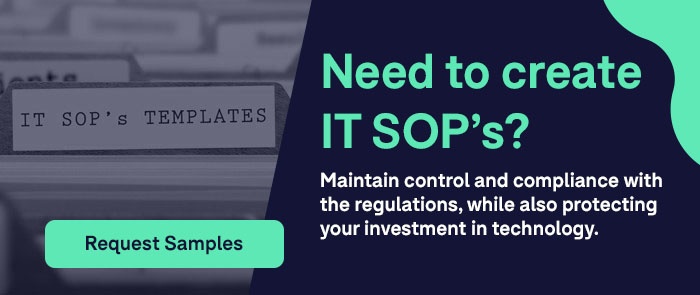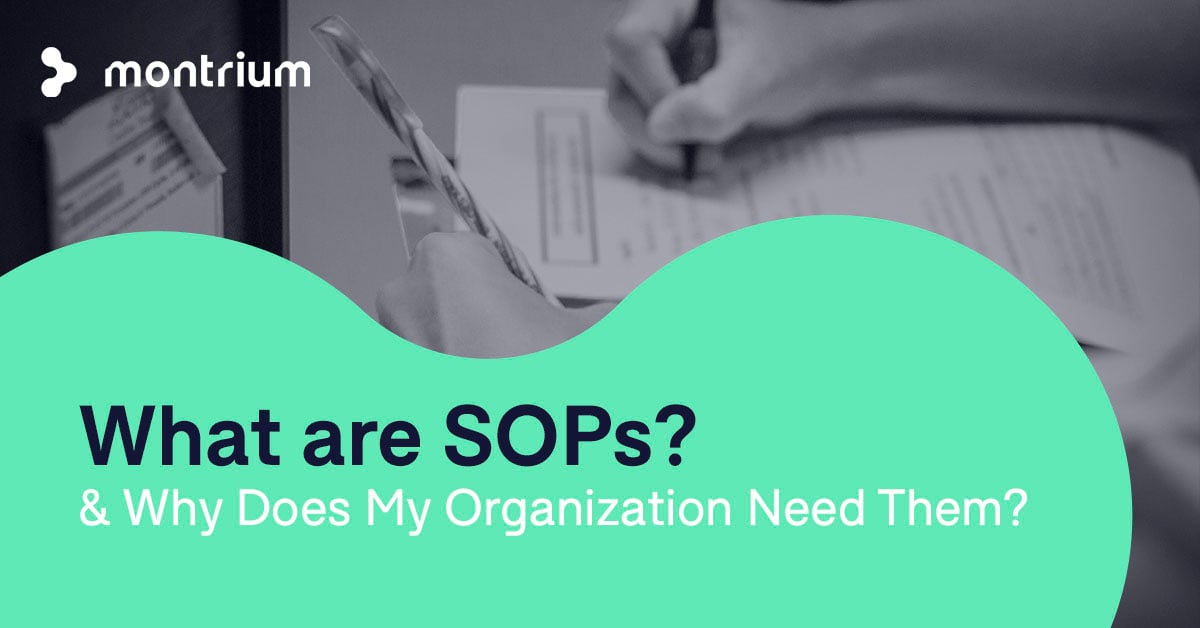The SOP development process is a great way for managers and their teams to collaborate in the documenting of processes for everyone’s benefit. Developing and following a framework for SOP development creates a positive sense of teamwork and will lead to improving the efficiency of your workforce.
SOPs are not created overnight, they require attention to detail and an investigation into your key business processes. While the concept of creating SOPs may seem simple, not following a defined process and creating a badly written SOP can have a significant impact on your organization.
In this article, we outline our recommended step by step process for developing and managing SOPs within your organization.
STEP 1 – Develop a list of processes that you believe need SOP creation
The best way to complete this task is to have each manager talk with their teams in order to create a list of potential SOPs. Then, organize time for your management team to meet to review the lists keeping in mind that not all processes need to be formalized only those where there is a clear business requirement or need for standardization. Once the processes to move forward have been identified, the management group must continue their assessment to identify redundancies or if there are any SOPs that need to be linked when departments are undertaking the same or similar processes. However, this master list will not be your final list.
As you write SOPs, you’ll find you may be able to combine some processes while others may need to be split up into different SOPs. The main function of this list is to give you a necessary starting point.
If you’re struggling to develop this list, go on over to our list of essential IT SOPs. This will provide you with somewhere to get started.
Expert tip: It’s important to note that during this first step, you may be tempted to create SOPs for every process in your organization. This isn’t the goal here. As you will be held to the process you define through auditing and vendor assessments it’s best not to select processes that you foresee undergoing change in the future. What you don’t want to be doing is updating you’re SOPs every 2 weeks, as this really defeats the entire exercise of making your team more efficient. 
STEP 2 – Plan the process for developing and managing SOPs
Determine the format for your Standard Operating Procedures. Once you have your list ready, you need to begin to plan your process for creating your SOPS; this is your first procedure to create. First, you’ll have to determine the format of the SOPs. The format is how you’re going to describe your process. Will you do step by step narrative or will you use diagrams? Or will you use a combination of both? Once the format is defined, you can begin to create your SOP Template. It can be beneficial in some cases to research SOP formats online, identifying an SOP example to work from and that works for your organization.
Develop a robust SOP Template. When creating a template for your SOPs it’s important to remember that the end goal is to have all of your SOPs look and read the same way, for consistency. However, it is important to distinctly describe the different types of processes in each area of your business. This can be one of the more challenging aspects of writing SOPs. It's recommended to have at least two templates to review and comment on. Collectively, those writing the SOPs and those enforcing the SOPs must all agree on format and SOP Template. Montrium has developed a set of standard IT SOP Templates for organizations operating within regulated industries. Pre-made SOP templates that are based on industry standards provide organizations with a solid foundation for SOP creation, speeding up the time to developing documentation.
Establish a formal review process. Now you need to plan the process for reviewing the SOPs that you’re going to be creating. The review process should be outlined at the time your group is working on the SOP format and template. Create a formal review process that states who the SOP is sent to for approval once it is written. Also determine who has the final approval authority, usually Quality Assurance, and will ensure that processes are made effective and published within the organization’s quality system.
Determine how SOPs will be accessed. Finally, you need to determine how the SOPs will be provided to employees. Will everyone have access to a paper copy? Or will you be providing access to the procedures via a document management application (if you’re a Montrium customer, you may be aware of our Document Management software for managing SOPs, called SOP Connect). It’s also important at this point to determine who will be able to access these SOPs.
Now that you’ve defined your process for SOP Management, it’s time to look at how you’ll collect the information to write the Standard Operating Procedures.
STEP 3 – Collect information for the content of your SOP
Before you begin collecting information, it’s important to outline how you’ll do this.
Identify the subject matter experts you’ll need to get information from. One of the most common and effective ways to collect this information is scheduling interviews with the subject matter experts (SMEs). However, be sure to check before you begin the interviews with your SMEs to see if they already have documentation on a process.
Check for documentation that may already be available. Often a well-organized department will have some documented processes. If you can take this information and put it into your SOP template before the meeting it provides an added bonus to the exercise and can speed up information gathering. As you can imagine people tend to freeze up when asked how they do their job, so laying out this information ahead of time will give the interviewee an opportunity to get into the right frame of mind.
Begin interviewing your SMEs. With your SOP template in place, and any information already available in check you’re ready to begin the interviews. Interviewing subject matter experts who perform the process being documented is the best way to understand the process. Asking managers to describe a process that they don’t often perform could lead to misinformation or missing information. It’s important to understand that the people who actually do the work, know the process the best.
STEP 4 – Write, review and publish your SOP
Begin WRITING the first draft of the SOP. Once you’ve completed the steps in the SOP creation process and have developed your SOP Template you’re ready to actually write the SOP, adding all of the information into the template during and after the meeting. By doing this you’ll quickly see gaps in the information and can follow up with the SME as soon as possible. Once the SOP draft is completed and you and the interviewee feel comfortable that the procedure is complete and thorough; it’s time for the SOP to be reviewed.
REVIEW the drafted SOP for completeness and accuracy. The review process can become cumbersome if many people are required to review and approve the Standard Operating Procedure before it’s published. If possible, try and develop a manageable and achievable review process to facilitate the completion of this phase. In most organizations, a 3-tiered approach is adopted to appropriately review the document.
- Review with subject matter experts. Starting with the subject matter experts will enable you to look over the SOP one last time with the process expert and confirm the information is accurate.
- Obtain input from management. Once the SOP has been reviewed by the SME, it’s time for his or her superior or upper management to review for their approval.
- Submit to the Quality Assurance Group. Finally, provide the SOP to the quality assurance group at your organization. This individual will perform a final approval before publishing. At times, other groups may need to be brought in to review a specific SOP if the SOP directly impacts their department. As with anything else, when writing SOPs flexibility is key.
PUBLISH the SOP throughout your organization. Now that the review is complete, you’ll have to coordinate SOP publishing. Throughout the process, your organization has been discussing where and how SOPs will be distributed to employees once the SOPs are approved. Typically this is the responsibility of the quality assurance group and close liaison with the department manager for the SOP. This part of the process can be greatly facilitated by the use of an automated SOP Management system that manages document control. Much like Montrium’s SOP Connect application, with document control software SOPs can be distributed electronically and receipts of who and when SOPs were read can be captured automatically.
STEP 5 – Maintaining your SOP over time
Now that you’ve written your SOP and published it to the relevant individuals, it’s now time to set up some rules to periodically review the SOP for relevancy and accuracy as your business grows. The best way to ensure that this process is standardized and is completed properly is to document it. Yes, you thought right. An SOP for SOPs.
Keep your SOPs up to date. The best way to make SOPs useful is to keep them updated. Maintenance has the utmost importance. Be mindful that your organization has just spent a lot of time, energy and money on these documents. Without a periodic review of SOPs and regular updates, they can quickly become out-of-date which would be a complete waste of the time, energy and money investment that you and your team have made. To keep this from happening we recommend that most SOPs be reviewed at least every two years. Some SOPs may need to be reviewed on a more frequent basis, especially if the process they explain is updated or changes.
Facilitate the periodic review process. If your organization is large or engages in a variety of process-driven activities, your list of effective SOPs may grow significantly over time. If you’re managing SOPs in double or even triple figures (which isn’t out of the ordinary) you may find it difficult to track and manage the periodic review dates of each SOP. Most SOP management solutions will provide functionality that automatically tracks and notifies you of the periodic review dates of each of your controlled SOPs. Even if you’re only managing a handful of procedures, having this “set and forget” functionality can remove a lot of manual work over time.



%20a%20Cloud-Based%20System.jpg)




